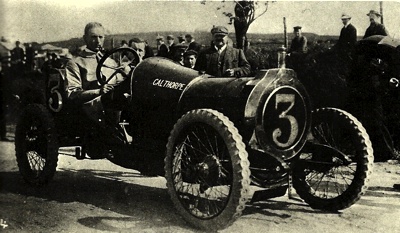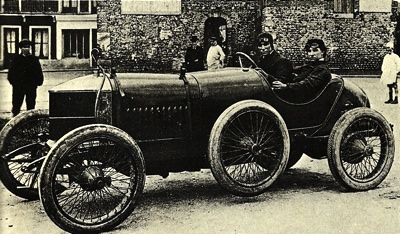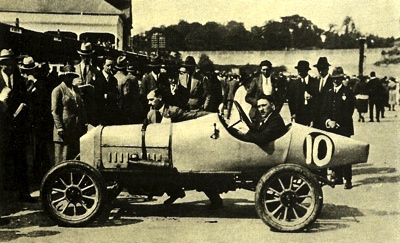Minstrel & Rea Cycle Works
During the early part of last century, many small manufacturers achieved fame and, in a few cases, fortune on production figures that would prove too small to be viable in the changed industrial climate of the late 1920s onwards. Typical of this breed of car maker was G. W. Hands who, at the turn of the century, was running the Minstrel & Rea Cycle Works in Barn Street, Birmingham. The Minstrel and Rea cycles were quality products which were usually sold direct to dealers who put their own transfers on them.
The Calthorpe Motor Company
In 1904, Hands formed the
Calthorpe Motor Company and introduced his first motor car, the 10 hp model with a four-cylinder Fafnir power unit and shaft drive. By the end of 1906, this had grown up into a 12/14hp costing 300 guineas in touring-car form. Alongside this, Hands was marketing a 28/40 hp four-cylinder model at twice the price; both models had Hele-Shaw multi-plate clutches, and were produced in the
Calthorpe company's new factory at Cherrywood Road, Bordesley Green, Birmingham.
White & Poppe Engines
The following year saw
Calthorpe concentrating on a new 16/20 hp White & Poppe-engined model, which was sold at UK£325 with side-entrance touring coach-work, plus another UK£25 for hood and windscreen, and another £20 extra for having magneto instead of coil ignition. During 1907 and 1908, the
Calthorpe Company's address was listed as John Bright Street, Birmingham; this was probably just a sales office, as the cars were still being produced at Cherrywood Road.
The 16/20 hp Roi des Beiges was still listed in 1908, but it had now been joined by a 25 hp four, with similar coach work, and a 10 hp two-cylinder. The distinguishing mark of the Calthorpe was its circular radiator, with raised header tank, which was seen on the 16/20 driven with some success by G. W. Hands in the 1908 Irish Trials; that same year, the marque managed a creditable fourth place in the 'Four-Inch' Race in the Isle of Man. They also competed in the 1909 Coupe des Voiturettes or Coupe de F Auto.
 Wiedman poses with his Calthorpe during the 1909 Circuit of Boulogne.
Wiedman poses with his Calthorpe during the 1909 Circuit of Boulogne.
 The Calthorpe Coupe de l'Auto which competed in the Voiturette race at Dieppe in 1912.
The Calthorpe Coupe de l'Auto which competed in the Voiturette race at Dieppe in 1912.
 1920 Calthorpe 10.5hp.
1920 Calthorpe 10.5hp.
 Calthorpe pictured at Brooklands in 1921.
Calthorpe pictured at Brooklands in 1921. |
Rudge-Whitworth Detachable Wheels
By 1910, the range had changed again; now it consisted of a 12/14 hp, a 15 hp and a 20 hp, all four-cylindered and all offering sound engineering at a moderate price. Hands Was racing cars at Brooklands by now, and there was also a somewhat abortive entry in the 1910 Coupe des Voiturettes. Rudge-Whitworth detachable wheels were added to the specification for 1911, in which year Burgess took sixth place in the Coupe des Voitures Legeres.
The marque's sporting achievements were reflected in the models exhibited at Olympia in November 1912; on their 11.9 hp chassis, the streamlined
Brooklands four-seater body was shown alongside the standard two and four-seater torpedo coachwork, while on the 15.9hp chassis, the Grand Prix four-seater was displayed.
The Calthorpe Minor
All models now came fully equipped with five detachable wheels, plus lamps and tyres (by no means common practice at that time); all Calthorpes except the Brooklands and Grand Prix also had hood and windscreen as standard. A new model appeared alongside the 11.9 and 15.9 at the 1931 Olympia Show; this was the immortal Calthorpe Minor, one of the first and best of the new generation of 'big cars in miniature'.
Even this managed to acquire a sound sporting record, and was available with striking pointed-tail bodywork. The basic two-seater was only £168, and the car enjoyed much success. The Minor was the sole post-Armistice model, and the pre-war tradition was continued by the availability of Mulliner round-tailed sporting coachwork.
The Hands
In 1922, G. W. Hands broke away from the
Calthorpe company to produce another light car, the Hands, in the old Minstrel & Rea Works in Barn Street which, in addition to cycles, was now also producing the Calthorpe motor-cycle range. There were two Hands models, the 10/20 hp four-cylinder side-valve and the 15/45 hp, which had the advanced feature of a single-overhead camshaft for its six-cylinder engine; it also boasted internal expanding
brakes all round.
Meanwhile, Calthorpe had introduced a new model, the 12/20, which had the unusual feature for the period of a non-detachable
cylinder head; access to the valves was only achieved by removing the top cover plate of the water jacket. 'This type of design not only gives water-cooled sockets for the sparking plugs', commented The Autocar, 'but avoids the use of cylinder joint gaskets, and at the same time permits even water spacing and well distributed cooling.'
Both 10 hp and 12/20 hp Calthorpes had four-speed transmissions now, and were noted for their hill-climb-ing abilities. The 1924 Motor Show saw a third model in the Calthorpe line-up, the 1991 cc 15/45, which bore a surprising resemblance to the Hands of the same designation.
This was hardly a matter for conjecture, however, for G. W. Hands's go-it-alone venture had proved unsuccessful, and he had returned to the Calthorpe Motor Company bringing the new design with him. It had, however, only two-wheel braking in its Calthorpe incarnation. All-round braking was restored at the end of 1925, at which time the 15/45 also acquired a four-speed transmission.
The Palace Hotel, Torquay
However, the Calthorpe's day was virtually over. Mass-produced models such as the Morris, Clyno and Swift were now so good that the more expensive Calthorpe could show little advantage over them. The Calthorpe factory closed down in 1927 and later that year it was reopened by the Colmore Depot as, ironically, a Morris service centre.
It seems, however, that a few Calthorpes were built after that, in the old cycle works, which was now producing the famous Ivory Calthorpe motor cycles. G. W. Hands, though, was not connected with those last sad remnants of a once-famous company. He had taken over the Palace Hotel, Torquay.



